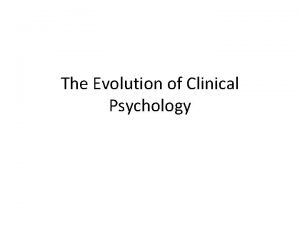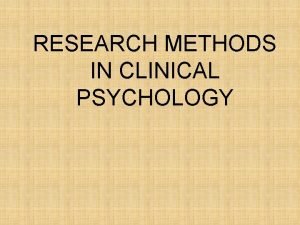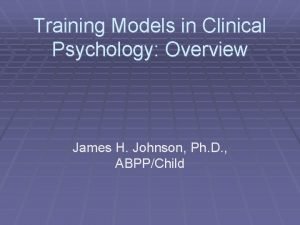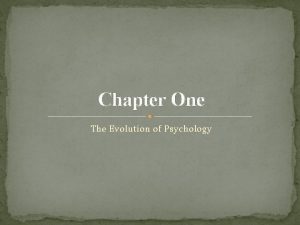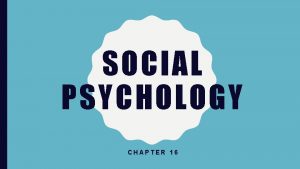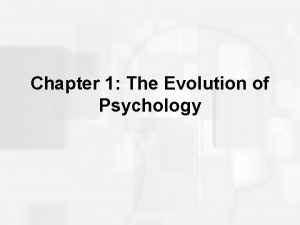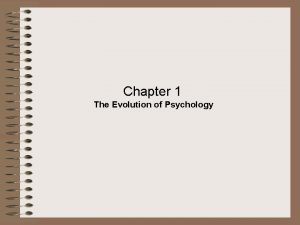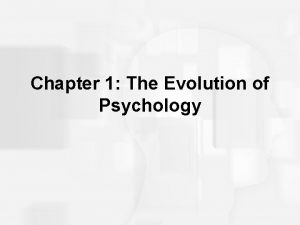Chapter 2 Evolution of Clinical Psychology Evolution of
























- Slides: 24

Chapter 2 Evolution of Clinical Psychology

Evolution of Clinical Psychology • The emergence of clinical psychology around the turn of the 20 th century was preceded by numerous important historical events • These events “set the stage” for clinical psychology • Some pioneers in the treatment of the mentally ill made important contributions in the 1700 s and 1800 s

Early Pioneers • William Tuke – 1732 -1822 – Lived in England – Appalled by deplorable conditions in “asylums” where mentally ill lived – Devoted much of his life to improving their treatment – Raised funds to open the York Retreat, a model of humane treatment

Early Pioneers • Phillippe Pinel – 1745 -1826 – Lived in France – Advocated for more humane and compassionate treatment of the mentally ill in France – Also introduced ideas of a case history, treatment notes, and illness classification, indicating care about their well-being

Early Pioneers • Eli Todd – 1762 -1832 – A physician in Connecticut – At the time, there were very few hospitals for the mentally ill • Burden for their care fell on families – Using Pinel’s efforts as a model, he opened humane treatment centers in US

Early Pioneers • Dorothea Dix – 1802 -1887 – Worked in a prison in Boston, and observed that many inmates were mentally ill rather than criminals – Traveled to various cities to persuade leaders to build facilities for humane treatment of mentally ill – Resulted in over 30 state institutions in US and other countries

Lightner Witmer and the Creation of Clinical Psychology • Lightner Witmer – 1867 -1956 – Received doctorate in 1892 in Germany – Psychology was essentially academic; no practice, just study – In 1896, Witmer founded the first psychological clinic at the U. of Pennsylvania

Lightner Witmer and the Creation of Clinical Psychology • By 1914, there were about 20 clinics in US • By 1935, there were over 150 • Witmer also founded the first scholarly clinical psychology journal, The Psychological Clinic, in 1907

Evolution of Assessment: Diagnostic Issues • Diagnosis and categorization of mental illness has been central to clinical psychology from the start • Emil Kraepelin (1855 -1926) is considered a pioneer of diagnosis – Coined some of the earliest terms to categorize mental illness

Evolution of Assessment: Diagnostic Issues • Kraepelin’s work set the stage for the Diagnostic and Statistical Manual (DSM), which continues to dominate diagnosis today • Published by American Psychiatric Association, originally in 1952

Evolution of Assessment: Diagnostic Issues • • DSM— 1952 DSM-II— 1968 DSM-III— 1980 DSM-III-R— 1987 DSM-IV— 1994 DSM-IV-TR— 2000 DSM-5— 2013

Growth of the DSM Disorders Pages 350 1000 900 300 292 886 297 800 265 250 700 600 200 182 567 500 150 100 991 494 400 300 106 200 50 100 134 0 0 DSM-1 (1952) DSM-II (1968) DSM-III (1980) DSM-III-R (1987) DSM-IV (1994) DSM-I (1952) DSM-II (1968) DSM-III (1980) DSM-IV (1987) DSM-IV-TR (1994) DSM-5 (2013)

Evolution of Assessment: Diagnostic Issues • Most drastic change in DSMs is from DSM-II to DSM-III – Larger, including more disorders – Specific diagnostic criteria – Multi-axial system • DSM-IV-TR to DSM-5 – Removal of the multi-axial system • As a general trend, as the DSM has been revised, it has expanded to include a greater number of disorders – “Scientific discovery” or “social invention? ”

Evolution of Assessment: Diagnostic Issues • Currently, numerous disorders are under consideration for inclusion in next DSM (“proposed criteria sets”) – Internet gambling disorder – Attenuated psychosis syndrome – Persistent complex bereavement – Nonsuicidal self-injury – others

Evolution of Assessment: Assessment of Intelligence • Assessment of intelligence characterized the profession in early years • Early debates about the definition of intelligence focused on “g” (a single, general intelligence) vs. ”s” (specific intelligences) • Alfred Binet’s early intelligence test (1905) later became the Stanford-Binet Intelligence Scales, which is still widely used today

Evolution of Assessment: Assessment of Intelligence • Binet’s test was intended for children • David Wechsler published the Wechsler. Bellevue in 1939, which was designed for adults • Wechsler later created tests for school-age and preschool children • Revisions of Wechsler’s tests are among the most commonly used today

Evolution of Assessment: Assessment of Personality • Projective tests were among the first to emerge—clients “project” personality onto ambiguous stimuli – Rorschach Inkblot Method— 1921 • Clients respond to ambiguous inkblot – Thematic Apperception Test (TAT)— 1935 • Clients respond to ambiguous interpersonal scenes

Evolution of Assessment: Assessment of Personality • Objective tests soon followed projectives – Typically paper-and-pencil, self-report, and more scientifically sound – MMPI (1943)—comprehensive personality test measuring various pathologies – MMPI-2 (1989)—revised and restandardized – MMPI-A (1992)—for adolescents

Sample MMPI and Rorschach Stimuli • T/F I like magazines about motorcycles. Sometimes I lie to get what I want.

Evolution of Psychotherapy • Psychotherapy is the most common activity of clinical psychologists today, but before the 1940 s/1950 s, it was not a significant professional activity – Treatment was by medical doctors, not psychologists • World War II created a demand for treatment of psychologically affected soldiers – Wars have had many other influences on the evolution of assessment and psychotherapy

Evolution of Psychotherapy • When psychotherapy became a more common activity in the mid 1900 s, the psychodynamic approach dominated • In the decades that followed, numerous other approaches arose: – Behaviorism – Humanism – Family Therapy • Most recently, cognitive therapy has risen to become the most widely endorsed singular orientation

Development of the Profession • At the historic Boulder conference in 1949, directors of graduate training programs agreed on a dual emphasis on practice and research • In the 1950 s, 1960 s, and 1970 s, – Therapy approaches proliferated – More minorities entered the field – Psy. D. /Vail model programs emerged

Development of the Profession • In the 1980 s, – Psychotherapy thrived, in part due to increasing respect from medical professionals and insurance companies – The number of training programs and new clinical psychologists increased

Development of the Profession • In the 1990 s and 2000 s, – The size and scope of the field continues to grow – Multiple training model options are available – Empirical support of clinical techniques, prescription privileges, and new technologies are among major contemporary issues
 Social psychology definition
Social psychology definition Nature of clinical psychology
Nature of clinical psychology Research design in clinical psychology
Research design in clinical psychology Controversies in clinical psychology
Controversies in clinical psychology Penn state university clinical psychology
Penn state university clinical psychology Clinical psychology definition
Clinical psychology definition Cultural issues in clinical psychology
Cultural issues in clinical psychology Models of clinical psychology
Models of clinical psychology Masters in clinical psychology uae
Masters in clinical psychology uae Pure psychology
Pure psychology Clinical psychologist
Clinical psychologist Doctorate in clinical psychology clearing house
Doctorate in clinical psychology clearing house Contemporary clinical psychology
Contemporary clinical psychology Clinical psychology science practice
Clinical psychology science practice Positive psychology ap psychology definition
Positive psychology ap psychology definition Fundamental attribution error ap psychology
Fundamental attribution error ap psychology Social psychology definition psychology
Social psychology definition psychology Health psychology definition ap psychology
Health psychology definition ap psychology Delmar learning medical abbreviations
Delmar learning medical abbreviations Chapter 45 introduction to the clinical laboratory
Chapter 45 introduction to the clinical laboratory Chapter 16 evolution of populations vocabulary review
Chapter 16 evolution of populations vocabulary review Chapter 17 evolution of populations answer key
Chapter 17 evolution of populations answer key Chapter 15 darwin's theory of evolution
Chapter 15 darwin's theory of evolution Chapter 7 the evolution of living things answers
Chapter 7 the evolution of living things answers Evolution and community ecology guided notes
Evolution and community ecology guided notes

